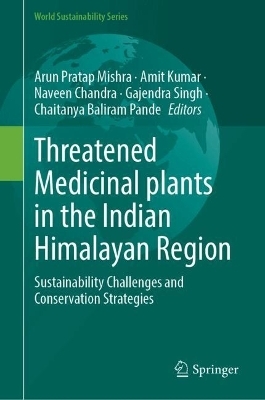
Threatened Medicinal plants in the Indian Himalayan Region
Springer International Publishing (Verlag)
978-3-031-73686-5 (ISBN)
- Noch nicht erschienen - erscheint am 07.02.2025
- Versandkostenfrei innerhalb Deutschlands
- Auch auf Rechnung
- Verfügbarkeit in der Filiale vor Ort prüfen
- Artikel merken
The book provides an in-depth analysis of the major issues related to the conservation of threatened medicinal plants in the Indian Himalayan region. The book is a comprehensive resource and sustainability of challenges and conservation strategies that highlights the critical role of medicinal plants in traditional healthcare systems and identifies the significant threats that these plants face due to various anthropogenic and natural factors. The book covers ten major themes that are critical to understanding the sustainability conservation of threatened medicinal plants in the Indian Himalayan region. It provides an essential resource for researchers, policymakers, and practitioners interested in the sustainability conservation of threatened medicinal plants in the Himalayan area. The book provides an overview of the major issues related to medicinal plant sustainability conservation and suggests strategies for the sustainable management of these plants. The authors have provideda comprehensive and insightful analysis of the sustainability conservation status of medicinal plants in the region, highlighting the urgent need for concerted efforts to conserve these valuable resources.
Arun Pratap Mishra: Mr. Mishra has obtained a postgraduate degree in environmental science from Hemwati Nandan Bahuguna Garhwal (Central) University, Uttarakhand, India. He has demonstrated exceptional proficiency in various disciplines including vegetation characterization, image processing, Google Earth Engine, small-scale mapping, landscape ecology, species distribution modeling, plant community ecology, hydrological modeling, and water quality. Mishra has contributed to the scientific community by publishing 15 research articles, 7 book chapters, 3 conference papers, and 1 technical report. He has worked as a project fellow at Uttarakhand Space Application Center (USAC), Botanical Survey of India (BSI), Dehradun, Uttarakhand, and RBased Services Private Limited, Delhi, after completing his postgraduate diploma in (RS&GIS). Mishra is currently employed as a project associate at the Wildlife Institute of India.
Amit Kumar is currently a faculty at the Wildlife Institute of India and a visiting faculty at the Indira Gandhi National Forest Academy, Dehradun. He has also served as a faculty of Forestry at the Forest Research Institute University, Dehradun. He studied floristic diversity and plant functional types across various landforms in the cold-arid region of Nanda Devi Biosphere Reserve for doctoral thesis. His research interests include phytotaxonomy, medicinal plant diversity, and plant invasion ecology.
Naveen Chandra: Dr. Naveen Chandra is a researcher at Uttarakhand Space Application Centre, Dehradun. He did his postgraduation in 2016 and obtained Ph.D. degree from Kumaun University, Nainital, in 2022. He joined USAC on March 2017 and since then working on different aspect of Himalayan biodiversity. His research interest includes plant taxonomy and ecology, vegetation ecology, invasion ecology, high altitude physiology, medicinal plants, ecological modeling, application of remote sensing (RS), and geographic information system (GIS) in biodiversity and forestry research. Till now, he has 20 research papers, 2 book chapters, and 2 scientific reports to his credit. His research has involved conducting surveys of high-altitude areas in the western Himalayas to monitor vegetation pattern and perform long-term ecological monitoring.
Gajendra Singh: Dr. Singh currently works at the Uttarakhand Space Application Center (USAC) as a scientist. Earlier to joining USAC in November 2014, he worked as a research scholar at the Wildlife Institute of India (WII) and GB Pant National Institute of Himalayan Environment and Sustainable Development, Almora, for more than 10 years. His research interests include plant taxonomy, forest ecology, spatial phytoresource monitoring, and natural resource management. He has published over 60 research papers and book chapters in national and international journals till date.
Chaitanya Baliram Pande: Dr. Pande (IITM, Pune) received his Ph.D. from Sant Gadge Baba Amravati University, Amravati. He has more than a decade of university, research, and industrial experience. Dr. Pande is a reviewer of Earth Science Research Journal, American Journal of Geophysics, Geochemistry and Geosystems, Sustainable Water Resources Management (Springer journal), Modelling Earth Systems and Environment (Springer journal), Applied Geomatics, (Springer journal), Journal of Agriculture Sciences (Bioinfo Publication), Applied Water Science (Springer), Journal of the Institution of Engineers (India): Series A (Springer), Groundwater Sustainable Development (Elsevier journal), and Environmental Sustainable Development (Springer journal). He has published 40 research papers in international journals with Springer, Taylor and Francis, and Elsevier with more than 1800 citations. He has published five books with Springer Nature. He has presented more than 20 research papers in national and international conferences.
Threatened medicinal plants: Population assessment.- Threatened medicinal plants: Threat assessment.- Impact of tourism on diversity of threatened medicinal plants.- Impact of climate change on threatened medicinal plants.- Impact of excessive livestock grazing on the threatened medicinal plants.- Market and illegal trade of threatened medicinal plants.- Dependency and role of local communities in medicinal plant conservation.- Sustainability conservation strategies of threatened medicinal plants.- Sustainability challenges in threatened medicinal plant conservation.- Sustainable management of threatened medicinal plants.- Sustainability policy and planning for conservation of medicinal plants.
| Erscheint lt. Verlag | 7.2.2025 |
|---|---|
| Reihe/Serie | World Sustainability Series |
| Zusatzinfo | XVII, 309 p. 64 illus., 59 illus. in color. |
| Verlagsort | Cham |
| Sprache | englisch |
| Maße | 155 x 235 mm |
| Themenwelt | Naturwissenschaften ► Biologie ► Botanik |
| Naturwissenschaften ► Biologie ► Ökologie / Naturschutz | |
| Naturwissenschaften ► Geowissenschaften | |
| Schlagworte | conservation • Indian Himalayan region • Medicinal plants • Sustainability Development • Threatened medicinal plants |
| ISBN-10 | 3-031-73686-9 / 3031736869 |
| ISBN-13 | 978-3-031-73686-5 / 9783031736865 |
| Zustand | Neuware |
| Informationen gemäß Produktsicherheitsverordnung (GPSR) | |
| Haben Sie eine Frage zum Produkt? |
aus dem Bereich


